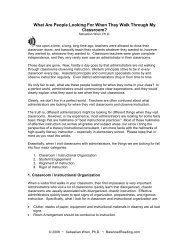The Abecedarian Reading Assessment - Balanced Reading
The Abecedarian Reading Assessment - Balanced Reading
The Abecedarian Reading Assessment - Balanced Reading
You also want an ePaper? Increase the reach of your titles
YUMPU automatically turns print PDFs into web optimized ePapers that Google loves.
Letter Knowledge<br />
To be a successful reader, students will need to be familiar and comfortable with the<br />
letters of the alphabet; they should be able to identify them without hesitation or<br />
confusion. Research has never shown that it is necessary for children to be familiar<br />
with the names of the letters – children taught with the Montessori method typically<br />
learn to identify letters with the sounds that correspond with the letter without any<br />
detrimental effects. However, research has shown that children learning to read should<br />
be able to easily and automatically discriminate the letters from each other (and from<br />
numbers and other letter-like symbols).<br />
<strong>The</strong> ability to quickly identify letters of the alphabet (by whatever means, be it letter<br />
name, sound, or a word that begins with the letter) is one of the best predictors of<br />
future reading success.<br />
For this subtest, fonts were chosen to test the limits of the child’s knowledge of and<br />
comfort with the letters of the alphabet. Non-alphabetic characters were added as well<br />
to increase the challenge. Children who are truly comfortable with the letters of the<br />
alphabet will have no difficulty with the fonts chosen, nor will they be distracted by nonalphabetic<br />
characters.<br />
Children should be able to rapidly identify all of the letters on the student sheet without<br />
struggling and without hesitation. A total score is not important in this task, but instead,<br />
teachers should pay attention to the types of response given, and teachers should look<br />
for confusions or hesitations.<br />
Hesitations in this assessment are as important as missed letters – a hesitation shows<br />
that the child is not yet fully familiar with the letter, and that more practice is needed. If<br />
the child spends more than two seconds trying to identify a letter, then that child is not<br />
yet comfortable and familiar with that letter.<br />
Children who are not able to quickly and accurately identify all of the letters of the<br />
alphabet (both lower-case and upper-case) may benefit from a letter-sorting activity.<br />
Put letter tiles or letter cutouts in a pile and ask the children to sort the letters by some<br />
salient feature (e.g. put all of the letters with straight lines in one pile and all the ones<br />
with curves in another), then ask them to sort them by another salient feature (e.g.<br />
diagonal lines versus lines that go up and down). <strong>The</strong>n by another and another until<br />
students are looking at small sets of two to four letters that have similar, confusing<br />
features, but which differ in important ways (e.g. O and Q or b, d, p, and q). When<br />
children can see confusing letters side by side, they can focus on the salient features<br />
that make those confusing letters distinct.<br />
For more ideas about instructional activities that could be used to help children develop<br />
letter knowledge, consult www.balancedreading.com.<br />
<strong>Abecedarian</strong> <strong>Reading</strong> <strong>Assessment</strong> • www.balancedreading.com • Page 5<br />
Letter Knowledge



